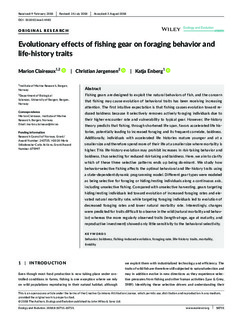| dc.description.abstract | Fishing gears are designed to exploit the natural behaviors of fish, and the concern that fishing may cause evolution of behavioral traits has been receiving increasing attention. The first intuitive expectation is that fishing causes evolution toward reduced boldness because it selectively removes actively foraging individuals due to their higher encounter rate and vulnerability to typical gear. However, life‐history theory predicts that fishing, through shortened life span, favors accelerated life histories, potentially leading to increased foraging and its frequent correlate, boldness. Additionally, individuals with accelerated life histories mature younger and at a smaller size and therefore spend more of their life at a smaller size where mortality is higher. This life‐history evolution may prohibit increases in risk‐taking behavior and boldness, thus selecting for reduced risk‐taking and boldness. Here, we aim to clarify which of these three selective patterns ends up being dominant. We study how behavior‐selective fishing affects the optimal behavioral and life‐history traits using a state‐dependent dynamic programming model. Different gear types were modeled as being selective for foraging or hiding/resting individuals along a continuous axis, including unselective fishing. Compared with unselective harvesting, gears targeting hiding/resting individuals led toward evolution of increased foraging rates and elevated natural mortality rate, while targeting foraging individuals led to evolution of decreased foraging rates and lower natural mortality rate. Interestingly, changes were predicted for traits difficult to observe in the wild (natural mortality and behavior) whereas the more regularly observed traits (length‐at‐age, age at maturity, and reproductive investment) showed only little sensitivity to the behavioral selectivity. | nb_NO |
